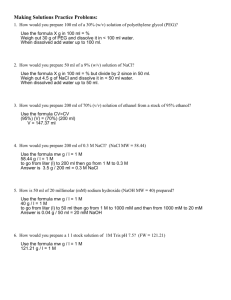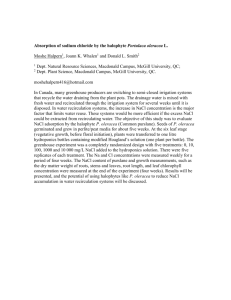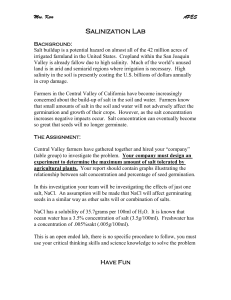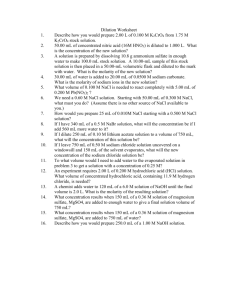EFFECTIVENESS OF SODIUMCHLORIDE
advertisement
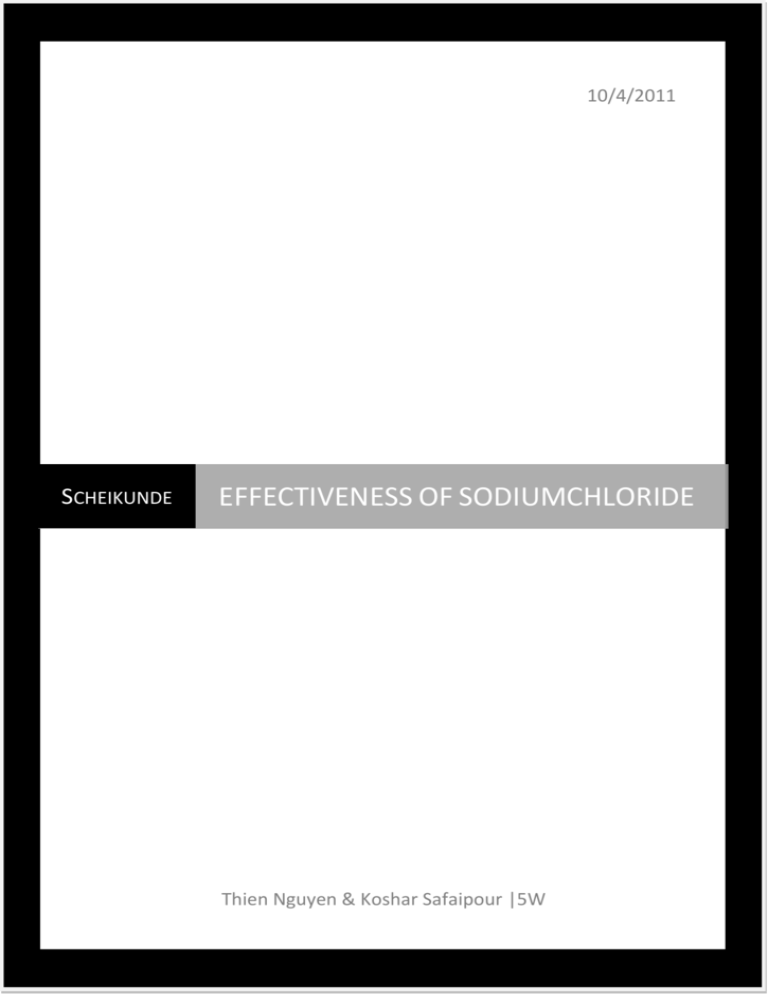
10/4/2011 SCHEIKUNDE EFFECTIVENESS OF SODIUMCHLORIDE Thien Nguyen & Koshar Safaipour |5W Effectiveness of Salt Nguyen T, Safaipour K. Willem de Zwijger College Papendrecht, The Netherlands Summary Road salt has saved many lives and it will continue saving lives. The only problem nowadays is that the Road salt sometimes isn’t suitable for the current temperature. There is second problem as well. Since there is a shortage of road salt, we mustn’t overuse it, so, we have to find the exact amount of salt which is needed for the exact temperature. In that order we wont waste anymore of our precious, life’s saving road salt. ___________________________________________________________ Introduction NaCl can lower the freezing point of the water. So our question is: how many gram of NaCl do we need to lower the freezing point of water with -1.0 °C and what is the minimum freezing point which we can reach of water. We expect that the lowest freezing point is 21˚C as we found that on an internet site. The maximum of NaCl per kg water is 358,5grams so we think a higher amount of NaCl should not have any effect anymore due to the fact that the solution is saturated. Also we expect a diminishing effectiveness of the salt (a small amount which has a stronger effect relatively than a large amount of NaCl). We are going to determine the average NaCl needed for a ∆-1.0 °C. After that, we can calculate how much salt there is needed for the -1,0 temperature drop which we desire. Experimental procedure and approach We took 9 identical tubes. All of them containing the same amount of water (100mL). Then we filled 8 of them with a variable amount of NaCl (amounts were between 5gram and 40gram with a ∆5gram, measured with a scale). All of the 8 tubes with solution and 1 tube with only water as control were placed in a refrigerator with temperature control. We lowered the temperature by 1˚C every X-minutes till the solution was the same temperature as the refrigerator indicated (X-minutes due to the fact that the different solutions froze in different amount of minutes). Then with a thermometer we measured the temperature of all the solutions to be sure they were the same temperature as the refrigerator indicator. The whole procedure was done twice as control. Data gathering and analysis Every 10 minutes we checked the temperature of the solutions with the thermometers. If it wasn’t the same as the refrigerator indicated then we waited a bit longer. Checking which solution was frozen, we noted the temperature which went along with it. We did this till every tube was frozen and repeated this for check up. On that basis we made a chart which helps us to see the connection. Results Table 1 presents the solutions (concentrations of NaCL in water) and the temperature which was needed to freeze the solutions. Amount of T in T in NaCL in Celsius Celsius 100mL water Exp. 1 Exp. 2 0 gram 0 0 5 gram -3 -4 10 gram -7 -7 15 gram -10 -10 20 gram -13 -12 25 gram -16 -15 30 gram -19 -19 35 gram -22 -21 40 gram -22 -21 Table 1: Temperature needed to freeze the solution. Figure 1 shows the temperature needed for a specific solution of NaCL in water. Figure 1: Average Temperature needed to freeze solution. Conclusion and discussion Looking critically at our experimental procedure and approach we see that in the set of experiments we kept the same variables constant: The amount of water in the solution, the tube the solution was in and of course the placement of the tubes in the refrigerator. As shown in Figure 1 ∆gram of NaCL is directly proportional with the ∆temperature of freezing. We were stunned by these results. This phenomenon wasn’t expected but after putting research in it we found out that the freezing point reduces linear with the amount of molecules that are present in the solution (not only for NaCl but every kind of salt!). We came to the second conclusion that the lowest freezing point of a solution with NaCl was indeed somewhere around 22˚C. Even after increasing the amount NaCl further to more than the water could contain (>35,85gram NaCL per 100mL water), it still froze on 22˚C. Because of the fact that the results were linear, we could calculate the ∆grams NaCl for a ∆-1,0˚C freezing point drop. ∆35grams/∆22˚C= ±1,6. So for every ∆-1,0˚C there is 1,6 grams needed (on a base of 100mL water). Between experiment 1 and 2 there were slightly differences, this because our refrigerator could only have a ∆1,0˚C and not a ∆0,1˚C which made it a bit less accurate. Bibliography 1.http://www.zoutman.com/nl/infor matie/wegenzout 2.http://nl.wikipedia.org/wiki/Strooiz out


